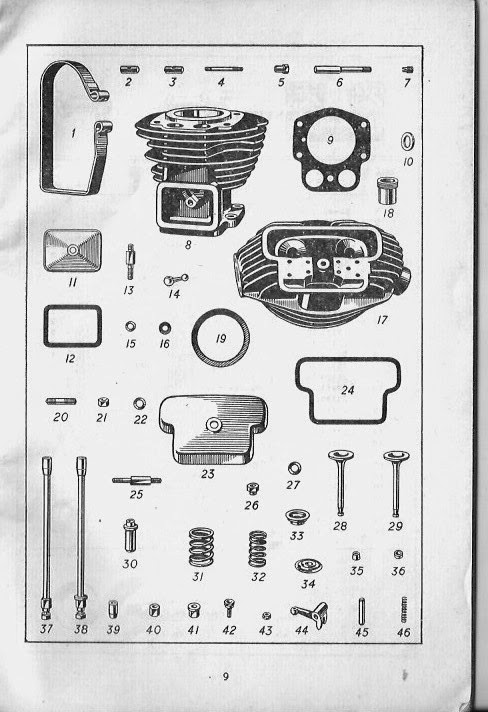 |
| Robert Edison Fulton Jr: 40,000 miles on a Douglas T6 |
Setting off for a globe-trotting trip on a motorcycle is pretty old-hat nowadays – revolutionaries enlarge their aura, celebs get TV shows off the back of it and the rest hope for a tiny flame of recognition to illuminate a sense of personal achievment, but probably just get moaned at by the wife when they return home (it's largely a male phenomenon).
If you can be arsed to look, there's a Wiki page devoted to long-distance bikers
here
The celebs go with a back-up truck and crew, the rest do it unsupported but on modern machines more than capable of the journey (notable exceptions include Ted Simon on a Meriden Triumph and Nick Sanders who covered 38,000miles on a 1990 Royal Enfield Bullet) but it's to the pioneers we must give the greatest praise, wobbling off on machines that'd be hard-pushed to get you across town, piled high with crappy or else makeshift camping equipment and dressed in big shorts and pith helmets, saying fuck to safety and trusting to an innate sense of superiority and a high-handed manner with the natives.

One of the first – and definitely the first and only one mounted on a Douglas twin – to circumnavigate the globe was Robert Edison Fulton Jr, an American who, aged 23, was on the verge of returning home after a year's post-grad studying in Europe but decided instead to set off around the world on a motorcycle, recording the trip on 4000ft of 35mm motion picture stock and writing a book on his return, the somewhat obscurely titled
One Man Caravan (Harcourt, Brace & Co, New York, 1937).
Fulton's account places him at a dinner party in London in 1932 during which, when asked what he planned to do now his studies were at an end, responded completely out of the blue: "Go around the world on a motorcycle!" surprising himself as much as the other diners. If we can credit it, also at the party there happened to be a man who had recently taken over the failing Douglas motorcycle company of Hanham Road, Kingswood. A bike was promptly offered and accepted and with just a brief period of practise riding, Robert rode off into the sunset and the start of 40,000 miles – London to New York. Hmm…
 |
| Fulton astride the Douglas with his own annotations |
It
could be true, but there's that uncomfortable coincidence which sets the brake on belief. Certainly, Jeff Clew's
The Douglas Motorcycle,
The Best Twin (2nd Ed, Foulis, 1981) dismisses Fulton with little more than a paragraph on p121 citing the would-be world traveller's petitioning Harley-Davidson's London HQ for a machine and being turned away with a flea in his ear before approaching Douglas. There, Eddie Withers offered the young man a machine. What's more Clew reveals Fulton's 600cc T6 began the trip as a combination (with Withers as ballast until Douglas put down its collective foot) but the chair was abandoned following an accident in Belgium and it continued as a solo – none of which is mentioned in Fulton's book.
Fiction then? Well there's certainly a gloss of self-promoting hyperbole throughout but I think otherwise the book is a true account at least as Fulton saw it. Alongside, Fulton released a movie documentary of the trip entitled
Twice Upon a Caravan which is narrated by the author, widely available on DVD and genuinely enjoyable.
 |
| The movie of the book of the ride… |
 |
| 1930s mobile phone (actually a clockwork cine camera) |
 |
| With a little help from his friends… the T6 as a combination |
 |
| Fulton's attitude to those he met was in fact, quite enlightened |
 |
| The very latest in protective motorcycling leisurewear (for 1932) |
 |
| Fulton takes a toss… one of many |
 |
| Signed edition |
My copy of the book is a signed first edition published in 1937 and despite some misgivings over at least some of the 'amusing' anecdotes contained therein (at best apocryphal, at worst fiction) it is nonetheless a thoroughly enjoyable read, stuffed with photographs (many, I think, stills from the movie), delightful woodcut maps and pen-and-ink sketches, drawn by the author.
What it isn't, is a book about Douglas, the T6 flat twin, or even motorcycling, and those looking for a bike book to while away the dark evenings until the season begins again will be disappointed. As Fulton says, the bike exists only to carry the man and to enable him to get closer to the action. For him, it has no intrinsic value or attraction.
 |
| No 1930s journey would be complete without a naughty monkey |
But if the prospect of derring-do astride 6hp, with white knees flapping in the wind and a Smith and Wesson .32 revolver stashed between the crankcase and bashplate is your idea of high adventure seek out a copy. It has gone through several contemporary reprintings.
Incidentally, Robert Fulton had illustrious antecedents (his father was the president of Mack Trucks) and a productive life beyond this journey – Google him for further info.
 |
| The author and Douglas still together in his late 80s |





















































































